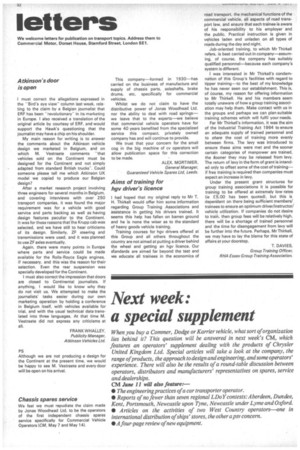Aims of training for hgv driver's licence
Page 34

If you've noticed an error in this article please click here to report it so we can fix it.
I had hoped that my original reply to Mr T. H. Thirkell would offer him some information regarding Group Training Associations and assistance in getting his drivers trained. It seems this help has fallen on barren ground and he is none the wiser as to the standard of heavy goods vehicle training.
Training courses for hgv drivers offered at this Group and all others throughout the country are not aimed at putting a driver behind the wheel and getting an hgv licence. Our standards are aimed far beyond the test and We educate all trainees in the economics of road transport, the mechanical functions of the commercial vehicle, all aspects of road transport law, and ensure that each trainee is aware of his responsibility to his employer and the public. Practical instruction is given in vehicles laden and unladen on all types of roads during the day and night.
Job-oriented training, to which Mr Thirkell refers, is best carried out in company—assuming,. of course, the company has suitably qualified personnel—because each company's system is different.
I was interested in Mr Thirkell's condemnation of this Group's facilities with regard to tipper training—to the best of my knowledge he has never seen our establishment. This is, of course, my reason for offering information to Mr Thirkell. He and his members seem totally unaware of how a group training association may help them. Make contact with us in the groups and perhaps we can plan suitable training schemes which will fulfil your needs.
For Mr Thirkell's information, it was the aim of the Industrial Training Act 1964 to ensure an adequate supply of trained personnel and to share the cost of training more evenly between firms. The levy was introduced to ensure these aims were met and the sooner certain categories of manpower are trained, the tooner they may be released from levy. The return of levy in the form of grant is intended only to offset some of the cost of training— if free training is required then companies must expect an increase in levy.
Under the present grant structures for group training associations it is possible for training to be offered at extremely low rates lie £5.00 has been quoted), but this is deperident on there being sufficient members/ trainees to ensure an optimum driver/instructor/ vehicle utilization. If companies do not desire to traih, then group fees will be relatively high, there will be a shortage of trained personnel and the time for disengagement from levy will be further into the future. Perhaps, Mr Thirkell, we may have to lay the blame for this state of affairs at your doorstep.
T. DAVIES. Group Training Officer, RHA Essex Group Training Association.
































































































